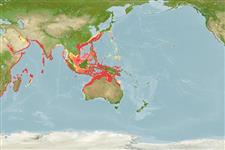Common names from other countries
Issue
Type locality: Mafia Island, Tanzania.
Environment: milieu / climate zone / depth range / distribution range
Ecologia
marinhas associadas(os) a recifes; intervalo de profundidade 10 - 400 m (Ref. 89707). Tropical; 35°N - 32°S, 29°E - 150°E (Ref. 5222)
Indo-West Pacific: Red Sea and East Africa to southern Japan and Queensland, Australia. Also from the Paracel Islands in the South China Sea. There are no records from Madagascar, Mauritius, Maldives, Laccadives, and Sri Lanka, Indonesia, and the Philippines.
Comprimento de primeira maturação / Tamanho / Peso / Idade
Maturity: Lm ?, range 99 - ? cm
Max length : 200 cm TL macho/indeterminado; (Ref. 2872); peso máx. publicado: 110.0 kg (Ref. 9710)
Espinhos dorsais (total) : 11; Raios dorsais (total) : 14 - 15; Espinhos anais: 3; Raios anais : 8. Distinguished by the following characteristics: body depth contained 2.9-3.5 times in SL; head length 2.3-2.6 times in SL; slightly convex interorbital area; straight dorsal head profile; rounded or subangular preopercle, slightly enlarged serrae at angle; almost straight upper edge of operculum; posterior and anterior nostrils subequal in size; maxilla reaches to or beyond vertical at rear edge of eye; 2-6 rows of teeth on midlateral part of lower jaw (Ref. 89707).
Mainly found in deep reef channels and seamounts, in current prone areas (Ref. 48635). Juveniles may be found in tide pools (Ref. 5222). Feeds on reef fishes, skates, crabs, and spiny lobsters (Ref. 5222). Considered to be exceedingly territorial and very aggressive towards intruders. Vulnerable to spear fishers (Ref. 5222). Hand fed by divers in certain areas, but potentially dangerous to the inexperienced. In the Hong Kong live fish markets (Ref. 27253). Solitary (Ref 90102).
Ciclo de vida ou comportamento de acasalamento
Maturities | Reprodução | Spawnings | Egg(s) | Fecundities | Larvas
Heemstra, P.C. and J.E. Randall, 1993. FAO Species Catalogue. Vol. 16. Groupers of the world (family Serranidae, subfamily Epinephelinae). An annotated and illustrated catalogue of the grouper, rockcod, hind, coral grouper and lyretail species known to date. Rome: FAO. FAO Fish. Synop. 125(16):382 p. (Ref. 5222)
Status na Lista Vermelha da UICN (Ref. 130435)
CITES (Ref. 128078)
Not Evaluated
Ameaça para os humanos
Harmless
Uso pelos humanos
Pescarias: pesca de subsistência; peixe esportivo: sim
Ferramentas
Relatórios especiais
Baixar XML
Fontes da internet
Estimates based on models
Preferred temperature (Ref.
115969): 16.8 - 27.7, mean 23.9 (based on 619 cells).
Índice de diversidade filogenética (Ref.
82804): PD
50 = 0.5000 [Uniqueness, from 0.5 = low to 2.0 = high].
Bayesian length-weight: a=0.01479 (0.00762 - 0.02872), b=3.05 (2.89 - 3.21), in cm Total Length, based on LWR estimates for this species & Genus-body shape (Ref.
93245).
Nível Trófico (Ref.
69278): 4.1 ±0.66 se; based on food items.
Resiliência (Ref.
120179): Baixo, tempo mínimo de duplicação da população 4,5 - 14 anos (Preliminary K or Fecundity.).
Fishing Vulnerability (Ref.
59153): High to very high vulnerability (66 of 100).
